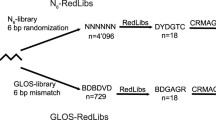Abstract
In molecular biology and cell factory engineering, tools that enable control of protein production and stability are highly important. Here, we describe protocols for tagging genes in Escherichia coli allowing for inducible degradation and transcriptional control of any soluble protein of interest. The underlying molecular biology is based on the two cross-kingdom tools CRISPRi and the N-end rule for protein degradation. Genome editing is performed with the CRMAGE technology and randomization of the translational initiation region minimizes the polar effects of tag insertion. The approach has previously been applied for targeting proteins originating from essential operon-located genes and has potential to serve as a universal synthetic biology tool.
Access this chapter
Tax calculation will be finalised at checkout
Purchases are for personal use only
Similar content being viewed by others
References
Brockman IM, Prather KLJ (2015) Dynamic metabolic engineering: new strategies for developing responsive cell factories. Biotechnol J 10:1360–1369
Schrader EK, Harstad KG, Matouschek A (2009) Targeting proteins for degradation. Nat Chem Biol 5:815–822
McGinness KE, Baker TA, Sauer RT (2006) Engineering controllable protein degradation. Mol Cell 22:701–707
Cameron DE, Collins JJ (2014) Tunable protein degradation in bacteria. Nat Biotechnol 32:1276–1283
Taxis C, Stier G, Spadaccini R et al (2009) Efficient protein depletion by genetically controlled deprotection of a dormant N-degron. Mol Syst Biol 5:1–7
Bachmair A, Finley D, Varshavsky A (1986) In vivo half-life of a protein is a function of its amino-terminal residue. Science 234:179–186
Tobias JW, Shrader TE, Rocap G et al (1991) The N-end rule in bacteria. Science 254:1374–1377
Rivera-Rivera I, Román-Hernández G, Sauer RT et al (2014) Remodeling of a delivery complex allows ClpS-mediated degradation of N-degron substrates. Proc Natl Acad Sci U S A 111:E3853–E3859
Gonda DK, Bachmair A, Wünning I et al (1989) Universality and structure of the N-end rule. J Biol Chem 264:16700–16712
Potuschak T, Stary S, Schlögelhofer P et al (1998) PRT1 of Arabidopsis thaliana encodes a component of the plant N-end rule pathway. Proc Natl Acad Sci U S A 95:7904–7908
Martínez V, Lauritsen I, Wolff T et al (2017) CRISPR/Cas9-based genome editing for simultaneous interference with gene expression and protein stability. Nucleic Acids Res. https://doi.org/10.1093/nar/gkx797
Kapust RB, Tözsér J, Copeland TD et al (2002) The P1′ specificity of tobacco etch virus protease. Biochem Biophys Res Commun 294:949–955
Erbse A, Schmidt R, Bornemann T et al (2006) ClpS is an essential component of the N-end rule pathway in Escherichia coli. Nature 439:753–756
Qi LS, Larson MH, Gilbert LA et al (2013) Repurposing CRISPR as an RNA-guided platform for sequence-specific control of gene expression. Cell 152:1173–1183
Ronda C, Pedersen LE, Sommer MOA et al (2016) CRMAGE: CRISPR optimized MAGE recombineering. Sci Rep 6:19452
Kozak M (2005) Regulation of translation via mRNA structure in prokaryotes and eukaryotes. Gene 361:13–37
McCarthy JE, Gualerzi C (1990) Translational control of prokaryotic gene expression. Trends Genet 6:78–85
Mirzadeh K, Martínez V, Toddo S et al (2015) Enhanced protein production in Escherichia coli by optimization of cloning scars at the vector − coding sequence junction. ACS Synth Biol 4:959–965
Cavaleiro AM, Kim SH, Seppälä S et al (2015) Accurate DNA assembly and genome engineering with optimized uracil excision cloning. ACS Synth Biol 4:1042–1046
Bonde MT, Klausen MS, Anderson MV et al (2014) MODEST: a web-based design tool for oligonucleotide-mediated genome engineering and recombineering. Nucleic Acids Res 42:W408–W415
Sambrook J, Fritsch EF, Maniatis T (1989) Molecular cloning: a laboratory manual. Cold Spring Harbor Laboratory Press, Cold Spring Harbor, New York
Author information
Authors and Affiliations
Corresponding author
Editor information
Editors and Affiliations
Rights and permissions
Copyright information
© 2018 Springer Science+Business Media, LLC
About this protocol
Cite this protocol
Lauritsen, I., Martínez, V., Ronda, C., Nielsen, A.T., Nørholm, M.H.H. (2018). Bacterial Genome Editing Strategy for Control of Transcription and Protein Stability. In: Jensen, M.K., Keasling, J.D. (eds) Synthetic Metabolic Pathways. Methods in Molecular Biology, vol 1671. Humana Press, New York, NY. https://doi.org/10.1007/978-1-4939-7295-1_3
Download citation
DOI: https://doi.org/10.1007/978-1-4939-7295-1_3
Publisher Name: Humana Press, New York, NY
Print ISBN: 978-1-4939-7294-4
Online ISBN: 978-1-4939-7295-1
eBook Packages: Springer Protocols



